Latest update valid Microsoft Azure az-102 dumps, free online az-102 exam Practice Test
Share the latest Microsoft Azure az-102 dumps, 13 Exam Practice topics and test your strength. geekcert offers complete Microsoft Azure az-102 exam questions and answers. If you want to pass the exam easily, you can choose geekcert. If you are interested in hobbies. We shared the latest az-102 PDF you can download online!
Download Microsoft Azure az-102 PDF Online
[PDF] Free Microsoft az-102 pdf dumps download from Google Drive: https://drive.google.com/open?id=1IaunHjVrLlJaBzAWqMOh0jXxNpE53bAH
[PDF] Free Full Microsoft pdf dumps download from Google Drive: https://drive.google.com/open?id=1gdQrKIsiLyDEsZ24FxsyukNPYmpSUDDO
Valid information provided by Microsoft officials
Exam AZ-102: Microsoft Azure Administrator Certification Transition: https://www.microsoft.com/en-us/learning/exam-az-102.aspx
This exam is intended only for those candidates who have taken Exam 70-533: Implementing Microsoft Azure Infrastructure Solutions.
If you have not taken Exam 533, you will not earn a certification by taking this exam.
The transition exam is intended for people who have already demonstrated skills in the content domain by passing the existing exam(s)
that the new role-based certification exams will be replacing. They cover the delta between the current certification and what we expect
people who earn the new certification to be able to do. We don’t want to retest people on the same content where they have already
demonstrated competence by passing the existing exam.
Transition exams cover net new content, content that wasn’t covered in enough depth, and content on aspects of the technology that have
likely changed since someone took the exam. As a result, the transition exam is not shorter than a typical exam but more focused on the
key tasks and skills that were not assessed in the existing exam or certification that is being replaced.
Candidates for this exam are Azure Administrators who manage cloud services that span storage, security, networking, and compute
cloud capabilities. Candidates have a deep understanding of each service across the full IT lifecycle, and take requests for
infrastructure services, applications, and environments. They make recommendations on services to use for optimal performance and scale,
as well as provision, size, monitor, and adjust resources as appropriate.
Candidates for this exam should have proficiency in using PowerShell and the Command Line Interface. Candidates should have a basic
familiarity or knowledge of Azure Portal, ARM templates, operating systems, virtualization, cloud infrastructure, storage structures,
and networking
From AZ-100: Microsoft Azure Infrastructure and Deployment
- Manage Azure subscriptions and resources (5-10%)
- Implement and manage storage (5-10%)
- Configure and manage virtual networks (15-20%)
- Manage identities (15-20%)
From AZ-101: Microsoft Azure Integration and Security
- Evaluate and perform server migration to Azure (15-20%)
- Implement and manage application services (5-10%)
- Implement advanced virtual networking (5-10%)
- Secure identities (5-10%)
Latest effective Microsoft az-102 Exam Practice Tests
QUESTION 1
SIMULATIONClick to expand each objective. To connect to the Azure portal, type https://portal.azure.com in the
browser address bar. 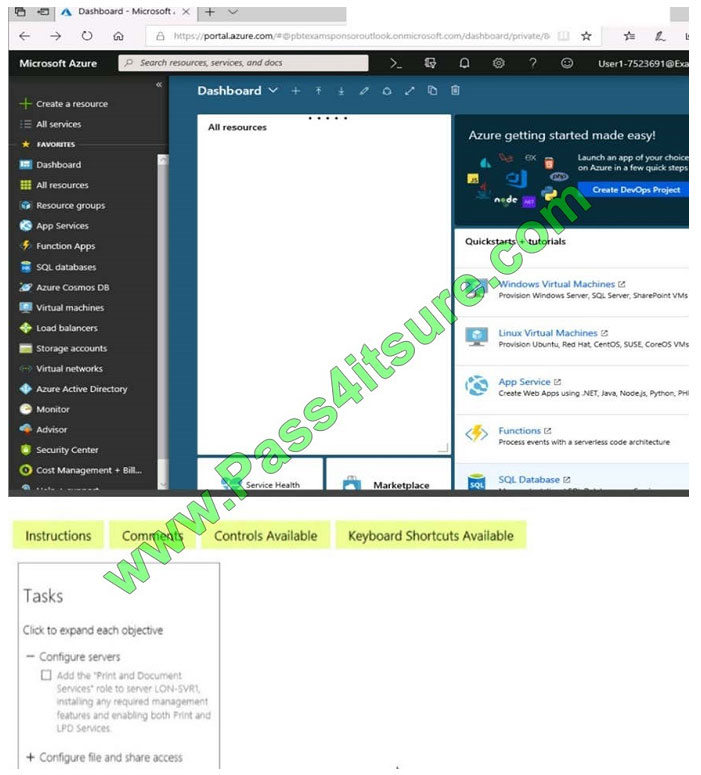
When you are finished performing all the tasks, click the \\’Next\\’ button.
Note that you cannot return to the lab once you click the \\’Next\\’ button. Scoring occur in the background while you
complete the rest of the exam.
Overview
The following section of the exam is a lab. In this section, you will perform a set of tasks in a live environment. While
most functionality will be available to you as it would be in a live environment, some functionality (e.g., copy and paste,
ability to navigate to external websites) will not be possible by design. Scoring is based on the outcome of performing
the tasks stated in the lab. In other words, it doesn\\’t matter how you accomplish the task, if you successfully perform it,
you will earn credit for that task.
Labs are not timed separately, and this exam may have more than one lab that you must complete. You can use as
much time as you would like to complete each lab. But, you should manage your time appropriately to ensure that you
are able to complete the lab(s) and all other sections of the exam in the time provided.
Please note that once you submit your work by clicking the Next button within a lab, you will NOT be able to return to
the lab.
To start the lab
You may start the lab by clicking the Next button.
You plan to protect on-premises virtual machines and Azure virtual machines by using Azure Backup. You need to
prepare the backup infrastructure in Azure. The solution must minimize the cost of storing the backups in Azure.
What should you do from the Azure portal?
Correct Answer:
First, create Recovery Services vault.
Step 1: On the left-hand menu, select All services and in the services list, type Recovery Services. As you type, the list
of resources filters. When you see Recovery Services vaults in the list, select it to open the Recovery Services vaults
menu. 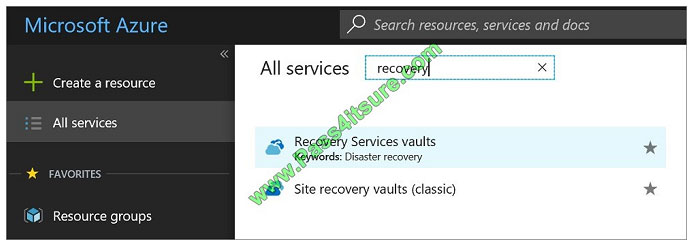
Step 2: In the Recovery Services vaults menu, click Add to open the Recovery Services vault menu.
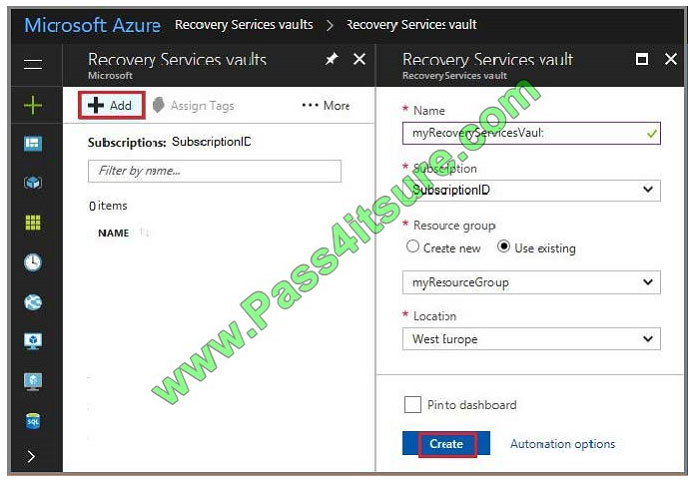
Step 3: In the Recovery Services vault menu, for example,
Type myRecoveryServicesVault in Name.
The current subscription ID appears in Subscription. If you have additional subscriptions, you could choose another
subscription for the new vault.
For Resource group select Use existing and choose myResourceGroup. If myResourceGroup doesn\\’t exist, select
Create new and type myResourceGroup.
From the Location drop-down menu, choose West Europe.
Click Create to create your Recovery Services vault.
References: https://docs.microsoft.com/en-us/azure/backup/tutorial-backup-vm-at-scale
QUESTION 2
You have an Azure subscription that contains a policy-based virtual network gateway named GW1 and a virtual network
named VNet1. You need to ensure that you can configure a point-to-site connection from VNet1 to an on-premises
computer. Which two actions should you perform? Each correct answer presents part of the solution.
NOTE: Each correct selection is worth one point.
A. Reset GW1.
B. Add a service endpoint to VNet1.
C. Add a connection to GW1.
D. Add a public IP address space to VNet1.
E. Delete GWL
F. Create a route-based virtual network gateway.
Correct Answer: EF
E: Policy-based VPN devices use the combinations of prefixes from both networks to define how traffic is
encrypted/decrypted through IPsec tunnels. It is typically built on firewall devices that perform packet filtering. IPsec
tunnel encryption and decryption are added to the packet filtering and processing engine.
F: A VPN gateway is used when creating a VPN connection to your on-premises network.
Route-based VPN devices use any-to-any (wildcard) traffic selectors, and let routing/forwarding tables direct traffic to
different IPsec tunnels. It is typically built on router platforms where each IPsec tunnel is modeled as a network interface
or VTI (virtual tunnel interface).
QUESTION 3
You are evaluating the name resolution for the virtual machines after the planned implementation of the Azure
networking infrastructure. For each of the following statements, select Yes if the statement is true. Otherwise, select
No.
Hot Area:
Correct Answer:
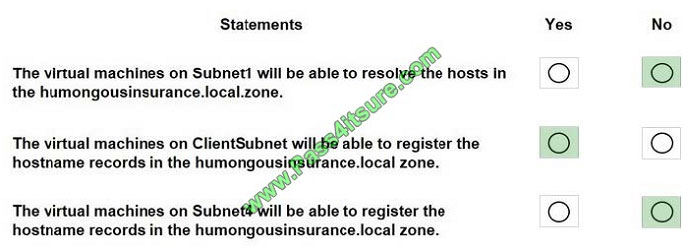
Scenario: You plan to create a private DNS zone named humongousinsurance.local and set the registration network to
the ClientResources-VNet virtual network.
There is a virtual network named ClientResources-VNet that will contain one subnet named ClientSubnet
Note: Azure DNS provides the following capabilities:
Automatic registration of virtual machines from a single virtual network that\\’s linked to a private zone as a registration
virtual network.
Forward DNS resolution is supported across virtual networks that are linked to the private zone as resolution virtual
networks.
Reverse DNS lookup is supported within the virtual-network scope.
References:
https://docs.microsoft.com/en-us/azure/dns/private-dns-overview
QUESTION 4
You are the global administrator for an Azure Active Directory (Azure AD) tenant named adatum.com. From the Azure
Active Directory blade, you assign the Conditional Access Administrator role to a user You need to ensure that Admin1
has just-in-time access as a conditional access administrator.
What should you do next?
A. Enable Azure AD Multi-Factor Authentication (MFA).
B. Set Admin1 as Eligible for the Privileged Role Administrator role.
C. Admin1 as Eligible for the Conditional Access Administrator role.
D. Enable Azure AD Identity Protection.
Correct Answer: A
Require MFA for admins is a baseline policy that requires MFA for the following directory roles: Global administrator
SharePoint administrator Exchange administrator Conditional access administrator Security administrator
References:
https://docs.microsoft.com/en-us/azure/active-directory/conditional-access/baseline-protection
QUESTION 5
You have an Azure Active Directory (Azure AD) tenant that has Azure AD Privileged Identity Management configured.
You have 10 users who are assigned the Security Administrator role for the tenant. You need the users to verify whether
they still require the Security Administrator role.
What should you do?
A. From Azure AD Identity Protection, configure a user risk policy.
B. From Azure AD Privileged Identity Management, create an access review.
C. From Azure AD Identity Protection, configure the Weekly Digest.
D. From Azure AD Privileged Identity Management, create a conditional access policy.
Correct Answer: B
References:
https://docs.microsoft.com/en-us/azure/active-directory/privileged-identity-management/pim- how-to-start-security-review
QUESTION 6
You have an Azure subscription named Subscnption1 that contains an Azure virtual machine named VM1.
VM1 is in a resource group named RG1.
VM1 runs services that will be used to deploy resources to RG1.
You need to ensure that a service running on VM1 can manage the resources in RG1 by using the identity of VM1.
What should you do fit
A. From the Azure portal modify the Access control (1AM) settings of VM1.
B. From the Azure portal, modify the Policies settings of RG1.
C. From the Azure portal, modify the value of the Managed Service Identity option for VM1.
D. From the Azure portal, modify the Access control (IAM) settings of RG1.
Correct Answer: C
A managed identity from Azure Active Directory allows your app to easily access other AAD-protected resources such
as Azure Key Vault. The identity is managed by the Azure platform and does not require you to provision or rotate any
secrets.
User assigned managed identities can be used on Virtual Machines and Virtual Machine Scale Sets.
References: https://docs.microsoft.com/en-us/azure/app-service/app-service-managed-service-identity
QUESTION 7
You have an Azure Active Directory (Azure AD) tenant named contosocloud.onmicrosoft.com.
Your company has a public DNS zone for contoso.com.
You add contoso.com as a custom domain name to Azure AD.
You need to ensure that Azure can verify the domain name.
Which type of DNS record should you create?
A. RRSIG
B. PTR
C. DNSKEY
D. TXT
Correct Answer: D
Create the TXT record. App Services uses this record only at configuration time to verify that you own the custom
domain. You can delete this TXT record after your custom domain is validated and configured in App Service.
References: https://docs.microsoft.com/en-us/azure/dns/dns-web-sites-custom-domain
QUESTION 8
You have an Azure Active Directory (Azure AD) tenant named contosocloud.onmicrosoft.com.
Your company has a public DNS zone for contoso.com.
You add contoso.com as a custom domain name to Azure AD.
You need to ensure that Azure can verify the domain name.
Which type of DNS record should you create?
A. NSEC
B. SRV
C. PTR
D. TXT
Correct Answer: D
Create the TXT record. App Services uses this record only at configuration time to verify that you own the custom
domain. You can delete this TXT record after your custom domain is validated and configured in App Service.
References: https://docs.microsoft.com/en-us/azure/dns/dns-web-sites-custom-domain
QUESTION 9
SIMULATION
Click to expand each objective. To connect to the Azure portal, type https://portal.azure.com in the browser address
bar.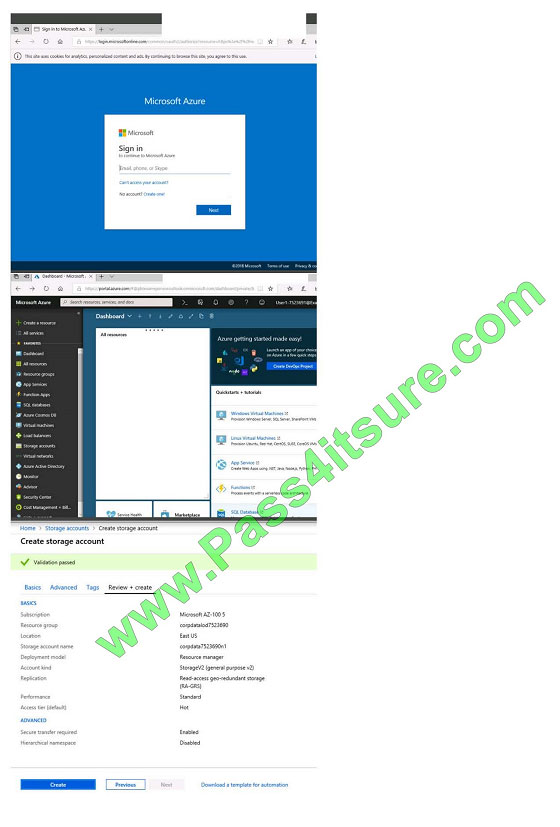
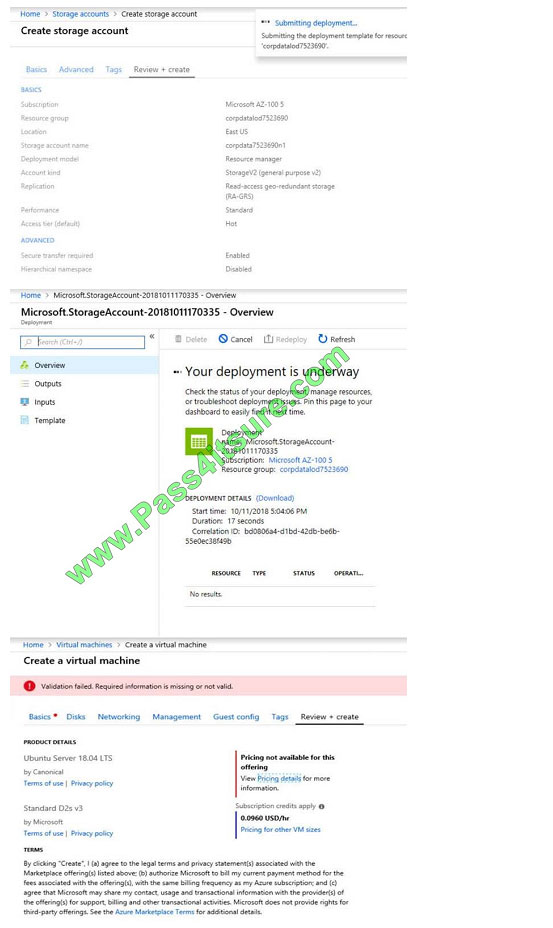
When you are finished performing all the tasks, click the \\’Next\\’ button.
Note that you cannot return to the lab once you click the \\’Next\\’ button. Scoring occur in the background while you
complete the rest of the exam.
Overview
The following section of the exam is a lab. In this section, you will perform a set of tasks in a live environment. While
most functionality will be available to you as it would be in a live environment, some functionality (e.g., copy and paste,
ability to navigate to external websites) will not be possible by design. Scoring is based on the outcome of performing
the tasks stated in the lab. In other words, it doesn\\’t matter how you accomplish the task, if you successfully perform it,
you will earn credit for that task.
Labs are not timed separately, and this exam may have more than one lab that you must complete. You can use as
much time as you would like to complete each lab. But, you should manage your time appropriately to ensure that you
are able to complete the lab(s) and all other sections of the exam in the time provided.
Please note that once you submit your work by clicking the Next button within a lab, you will NOT be able to return to
the lab.
To start the lab
You may start the lab by clicking the Next button.
You plan to deploy several Azure virtual machines and to connect them to a virtual network named VNET1007.
You need to ensure that future virtual machines in VNET1007 can register their name in an internal DNS zone named
corp7523690.com. The zone must NOT be hosted on a virtual machine.
What should you do from Azure Cloud Shell?
To complete this task, start Azure Cloud Shell and select PowerShell(Linux). Click Show Advanced Settings, and then
enter corp7523690n1 in the Storage account text box and File1 in the File share text box. Click Createstorage, and then
complete the task.
Correct Answer:
Step 1: New-AzureRMResourceGroup -name MyResourceGroup Before you create the DNS zone, create a resource
group to contain the DNS zone. Step 2: New-AzureRmDnsZone -Name corp7523690.com -ResourceGroupName
MyResourceGroup A DNS zone is created by using the New-AzureRmDnsZone cmdlet. This creates a DNS zone called
corp7523690.com in the resource group called MyResourceGroup. References: https://docs.microsoft.com/en-
us/azure/dns/dns-getstarted-powershell
QUESTION 10
You have two Azure Active Directory (Azure AD) tenants named contoso.com and fabrikam.com.
You have a Microsoft account that you use to sign in to both tenants.
You need to configure the default sign-in tenant for the Azure portal.
What should you do?
A. From the Azure portal, configure the portal settings.
B. From the Azure portal, change the directory.
C. From Azure Cloud Shell, run Set-AzureRmContext.
D. From Azure Cloud Shell, run Set-AzureRmSubscription.
Correct Answer: B
Change the subscription directory in the Azure portal.
The classic portal feature Edit Directory, that allows you to associate an existing subscription to your Azure Active
Directory (AAD), is now available in Azure portal. It used to be available only to Service Admins with Microsoft accounts,
but
now it\\’s available to users with AAD accounts as well.
To get started:
1.
Go to Subscriptions.
2.
Select a subscription.
3.
Select Change directory. Incorrect Answers:
C: The Set-AzureRmContext cmdlet sets authentication information for cmdlets that you run in the current session. The
context includes tenant, subscription, and environment information. References: https://azure.microsoft.com/en-
us/updates/edit-directory-now-in-new-portal/
QUESTION 11
DRAG DROP
You need to prepare the environment to ensure that the web administrators can deploy the web apps as quickly as
possible.
Which three actions should you perform in sequence? To answer, move the appropriate actions from the list of actions
to the answer area and arrange them in the correct order.
Select and Place: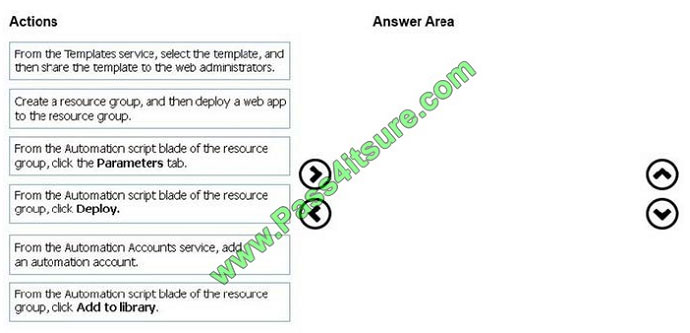
Correct Answer:
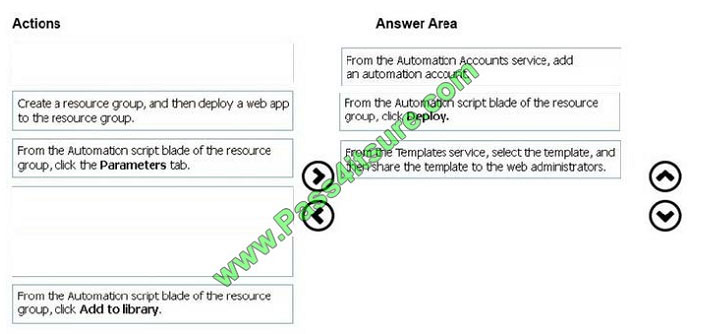
Explanation:
Step 1:
First you create a storage account using the Azure portal.
Step 2:
Select Automation options at the bottom of the screen. The portal shows the template on the Template tab.
Deploy: Deploy the Azure storage account to Azure.
Step 3:
Share the template.
Scenario: Web administrators will deploy Azure web apps for the marketing department. Each web app will be added to
a separate resource group. The initial configuration of the web apps will be identical. The web administrators have
permission to deploy web apps to resource groups. References: https://docs.microsoft.com/en-us/azure/azure-resource-
manager/resource-manager-quickstart-create-templates-use-the-portal
QUESTION 12
Note: This question is part of a series of questions that present the same scenario. Each question in the series contains
a unique solution that might meet the stated goals. Some question sets might have more than one correct solution,
while
others might not have a correct solution.
After you answer a question in this section, you will NOT be able to return to it. As a result, these questions will not
appear in the review screen.
You have an Azure subscription that contains 10 virtual networks. The virtual networks are hosted in separate resource
groups.
Another administrator plans to create several network security groups (NSGs) in the subscription.
You need to ensure that when an NSG is created, it automatically blocks TCP port 8080 between the virtual networks.
Solution: You configure a custom policy definition, and then you assign the policy to the subscription.
Does this meet the goal?
A. Yes
B. No
Correct Answer: A
Resource policy definition used by Azure Policy enables you to establish conventions for resources in your organization
by describing when the policy is enforced and what effect to take. By defining conventions, you can control costs and
more easily manage your resources.
References: https://docs.microsoft.com/en-us/azure/azure-policy/policy-definition
QUESTION 13
You need to recommend an identify solution that meets the technical requirements. What should you recommend?
A. federated single-on (SSO) and Active Directory Federation Services (AD FS)
B. password hash synchronization and single sign-on (SSO)
C. cloud-only user accounts
D. Pass-through Authentication and single sign-on (SSO)
Correct Answer: A
Active Directory Federation Services is a feature and web service in the Windows Server Operating System that allows
sharing of identity information outside a company\\’s network.
Scenario: Technical Requirements include:
Prevent user passwords or hashes of passwords from being stored in Azure.
References:https://www.sherweb.com/blog/active-directory-federation-services/
13 Microsoft Azure az-102 Exam Practice questions and answers have let you know your strength, if you are only interested then please pay attention to us! If you would like to pass the exam, please select our
recommended geekcert az-102 dumps. In this article we have created PDF and YouTube for everyone to learn from.
Like friends please add to favorites! We update all year round! Share more effective and up-to-date exam dumps for free!
geekcert Promo Code 15% Off

Why Choose geekcert?
geekcert is the best provider of IT learning materials and the right choice for you to prepare for Microsoft az-102 exam. Other brands started earlier, but the price is relatively expensive and the questions are not the newest. geekcert provide the latest real questions and answers with lowest prices, help you pass az-102 exam easily at first try.
